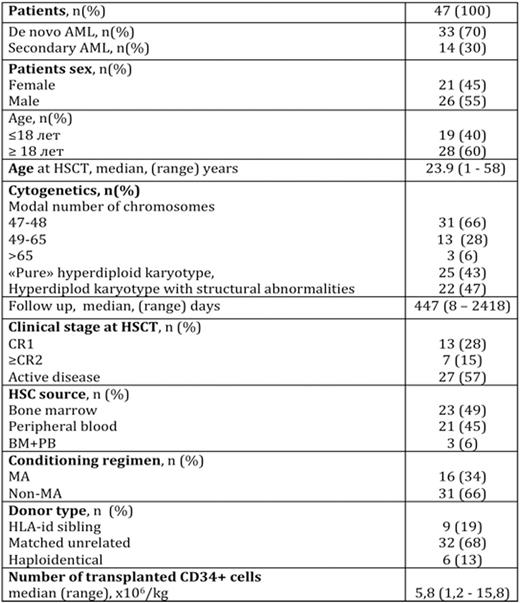Abstract
Background. Chromosome gain is frequent in acute myeloid leukemia (AML) and is counted alongside structural abnormalities when determining karyotype complexity. Meantime, there are no studies investigating the cytogenetic profile and outcome of patients with a hyperdiploid variant (HV, ³47 chromosomes) of AML after allogeneic stem cell transplantation (allo-HSCT).
Aim. To evaluate the prognostic impact of different cytogenetic characteristics, including the modal number, the number of chromosomal aberrations in complex karyotype (CK), the adverse chromosomal abnormalities (ACA) (monosomy 7/7q-, monosomy 5/5q-, monosomy 17/17p-,t(6;9)(p22;q34) on results of allogeneic stem cell transplantation (allo-HSCT) in patients with HV of AML.
Material and methods.Forty-seven patients with HV of AML (21 women and 26 men, aged from 1 to 58 years, median - 23,9 years) were examined.Analysis of overall and event-free survival predictors after allo-HSCT in patients with different clinical, transplant and cytogenetic characteristics was performed.
Results. The most common in the karyotype was the modal number of chromosome (MN) 47-48 which was observed in 31 (66 %) patients.Highhyperdiploidy with the modal number 49-65 wasidentified in13 (28 %) patients, near-triploidy and near-tetraploidy karyotypes were found in3 (6%) patients. Chromosomes were gained in a nonrandom pattern. Chromosome 8 (50 %), 21 (32 %), 13 (16 %)è 22 (16 %) were the most commonly gained. Structural chromosomal abnormalities were detected in 22 (47 %) patients, and the adverse chromosomal abnormalities were revealed in 7 (19 %) patients.In univariate analysis, overall survival (OS) and event-free survival (EFS) were various in patients with differentdisease status at transplantation (remission vs active disease; p=0.003 and p=0.002, respectively) and adverse chromosomal abnormalities inhyperdiploid karyotype (ACA- vs ACA+; p=0.001 and p=0.03, respectively). Additional analysis of selected patients group with structurally complex karyotype (n=19) showedthat the patients without ACA had OS higher than patients with ACA (p=0.03).In multivariate analysis, independent predictors of decreased OS and EFS were active disease at allo-HSCT (p=0.004èp=0.006, respectively) and the presence of the ACA (p=0.002 only for OS).
Conclusion. High-risk factors in patients with HV of AML treated by allo-HSCT are adverse chromosomal aberrations. Therefore, the patients with formal criteria Çcomplex karyotypeÈ should not automatically be assigned to the adverse cytogenetic risk group on the basis of complexity. Instead they should be assessed for the presence of specific chromosomal abnormalities, which are known to harbor an adverse effect.
Overall survival depending on clinical status at HSCT and the presence of adverse chromosomal abnormalities (-7/7q-,5q-,17p-,t(6;9) in patients with a hyperdiploid variant of AML.
Overall survival depending on clinical status at HSCT and the presence of adverse chromosomal abnormalities (-7/7q-,5q-,17p-,t(6;9) in patients with a hyperdiploid variant of AML.
No relevant conflicts of interest to declare.
Author notes
Asterisk with author names denotes non-ASH members.




